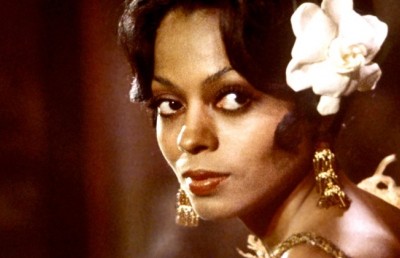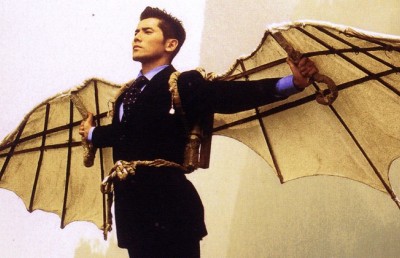Suicide, Regeneration, and a Tear upon Waking: Fantasia 2003
Cult Cats in FanTasia Space

Two of this year’s festival’s major recurrent themes – suicide and regeneration – might also be observed in the life of the festival itself over the past couple of years. Indeed, allowing the festival to be cancelled in 2002 (though largely due to circumstances outside of Fantasia’s control) was seen by many as an act of suicide. There was a definite feeling in that air that, after suffering such a blow, the festival would not be able to make a comeback. Thankfully such speculations did not find root in the realm of the concrete. Fantasia 2003 was a happening with the full zeal of re-born religious fanaticism, proof positive that there is indeed life after death, as so much of the festival’s programming sought to explore in cinematic terms. Indeed, this year’s festival boasted more representations of suicide than I have ever encountered within a single context. All the more interesting that all this suicide was coupled with thrice the amount of healing flesh. There are indeed strong connections to be made with the act of suicide and the desire to heal. In some ways, suicide might be seen as a quintessentially human desire to take the natural cycles of birth and death, undeniably dependent upon one another, into one’s own hands. I believe that screen representations of suicide are part of a larger fascination we have with the sights and sounds of corporeality. Indeed, after 27 days of incessant bloodletting, I started to get a sense of the cleansing qualities of sanguine flow, not unlike what I was taught as young acolyte on the altar of the Roman Catholic church of my upbringing. Fantasia has undoubtedly risen again, and we should all sing out its praises.
So, on that note, I will begin by addressing Fantasia’s new venue before getting to the substance of the festival’s programming along the themes of suicide and regeneration. The fact that it was not going to be held at the Imperial Cinema was the center piece around which much discussion of Fantasia’s potential demise was conducted. Let’s get one thing straight: the Imperial Cinema is probably the finest in the city of Montreal. So, to say that it’s a shame Fantasia couldn’t be there this year is to state the obvious. And to niggle about all the ways in which the Concordia facilities are not as good or nice as the Imperial is redundant. No kidding. Having said that, Concordia deserves much praise for their renovations of the sound and projection facilities within their largest lecture hall (H-110 in the Hall building). I’ll admit that when I first heard the festival was to be held in H-110 I was very sceptical. I’ve had many a class in that room over the years, so I’m painfully familiar with the facilities. However, after Resurrection of the Little Match Girl tore the roof off the place on the festival’s opening night, my fears were instantly alleviated. The new screen (now the largest standard cinema screen in the city) and top notch Dolby Digital sound are amazing. The seats are definitely the weak point, and proved to be very uncomfortable after several films in a row [ed. rumor has it that new seats may be in the cards for next year]. But not by much more than any other older theatre would be. On the plus side, the Hall Auditorium has inclined seating, so heads are rarely a problem. I’m 6’2’’ and I always had heads in my way on the floor of the Imperial, so I can only imagine how it would be for people shorter than I. With the majority of the films being subtitled, this always proved to be annoying. Also, the plan of the Hall room is much more open and comfortable than the Imperial. There is scarcely a bad seat in the house, largely due to not having the wing sections of standard theatres. And because the Hall building itself is intended for accommodating student traffics numbering in the thousands, the foyer outside the auditorium is extremely spacious, and the bathroom facilities ample. I don’t miss the line-up outside the tiny Imperial toilets at all, that’s for sure. Plus there is a whole mezzanine dedicated to housing the epic ticket purchasing line-ups, so that’s out of the way of the rest of the scene, and the street outside is not cluttered with other shops and whatnot for the long lines there to get in the way of. The whole thing just feels more spacious, open and friendly, and that is important for the environment of a festival like this. So, I applaud the foresight of Fantasia’s organizers this year, for this is far superior than if the festival were housed in a multiplex or other such facility. And while a complex like Ex-Centris is clearly first class, we all learned in 1999 how the ultra-modern stainless-steel environment doesn’t accommodate the Fantasia crowd particularly well. So, while I do miss the Gothic splendour and top notch projection facilities of the Imperial, Concordia is running up a close second in my books for this particular festival.
Fantasia having thus healed the severed limb that was the Imperial Theatre, they proceeded to unleash a dizzying array of films dealing with the healing of all kinds of wounds. The more obvious theme of regeneration was found in the basic premises for the requisite spate of Zombie and Vampire flicks. Undead proved to be an exceptionally well polished tale of a town’s gradual descent into zombiedom, only here the zombies were created by aliens who turn out to be somewhat benevolent in their intentions. A great otherworldly feeling pervaded throughout which made it stand out from the usual fare. And one character in particular, a police officer who spoke every word in the same vein as the legendary "Get in the back of the van!!" line from Withnail and I (1987, Bruce Robinson), added a hilarity to the proceedings that was much appreciated.
Mucha Sangre (2002, Pepe De Las Heras) could easily have been a Troma film were it not for its outstanding production values. Bad taste flying hot and heavy, the film even featured a monster penis that explodes semen after being shot to bits. This notable moment played well in tandem with Beyond the Re-Animator (2003, Brian Yuzna) which brings Jeffery Combs back as the hypodermic-wielding scientist who, while in jail, manages to leave a long trail of re-animated body parts in his wake, one of which being a severed penis that strikes up a kung-fu battle with a rat during the film’s closing credit sequence. Both Mucha Sangre and Beyond the Re-Animator offered up levels of absurdist gore that managed to stand out even in the context of Fantasia. Mucha in particular yielded one of the more outrageous plays on the dismemberment theme that so many zombie films depend upon: during a scene where a man gets hacked to pieces with a chainsaw, limbs flying all over the room, he continually grows new ones out of the old sockets as fast as they could be severed. A veritable feast of flying flesh for those inclined to enjoy bearing witness to such things. The regeneration special effects here were hilarious, and gave the scene a flavour that similar scenes found in the likes of Big Slaughter Club could simply not measure up to.
Jeepers Creepers 2 (2003, Victor Salva) featured the best zombie regeneration sequence of the festival, perhaps the only interesting part of the film. Knowing as we all do by now that the Creeper never dies, we get to see a glimpse of how his immortality operates on a practical level. After getting a javelin through his head, he proceeds to tear the head off of one of the hapless high school kids trapped in a bus on a deserted highway. Instead of just attaching it to his neck, however, as we have seen in countless other films, he sucks the head into his abdominal area and then cocoons himself with his wings. After a period of growth, we find that the head has worked its way through his torso and up through his neck where it then sits. The process is very organic feeling, and actually has some measure of credibility. It is also interesting in terms of the fact that in order to regenerate he needs to consume the life of something else, part of this dance of birth and death that so many of these films take as their basis.
Meanwhile other films were less overt, featuring characters that were seemingly invincible but for reasons not immediately clear. The duo Aragami (2003, Ryuhei Kitamura) and 2LDK (2003, Yukihiko Tsutsumi) are cases in point. Created as a kind of competition whereby the directors had identical budgets and were required to create a story revolving around two characters within a single enclosed space, these films both featured a conflict escalating to violence which no regular humans should have been able to endure. Indeed, the two Samurais in the mountain cave of Aragami turned out to be mythical beings, and their conflict rose to the aesthetic example set by Ishii Sogo in Gojoe a couple years back, complete with gunfire sparks flying off swords in the midst of stroboscopic flashes of impressionistic body movements set to a raucous electrified score. 2LDK, on the other hand, featured two young girls living together in an apartment who begin fighting over a boy of mutual interest. Their conflict rises to the likes of bathtub electrocutions and head clobberings with ceramic toilet lids. Yet they keep coming back for more, like the Bad Guy in Kim Ki-Duk’s film of the same name, who manages to recover from a four foot pane of jagged broken glass jammed right through his chest. But as they say, only the good die young. No rest for the wicked.
Many such examples can be dismissed as simply more of the ridiculous violence depicted in so many action movies. We are called upon to suspend all disbelief and accept the idea that these people can actually undergo such extreme levels of physical trauma. However, I think the Fantasia context allows for a deeper understanding of this drive to keep going against all odds. In addition to being a playground for these kinds of films, Fantasia is also a hotbed of intertextuality which suggests another form of constant consumption and regeneration that is clearly not lost on its audience. In many ways, the dialogue that exists between so many of these films (be it through their general self-reflexive genre re-interpretations or through specific homages to given films) is what allows audiences to return time and again. The festival acts as an environment of relationships. Any avid festivalier will attest to the fact that, much as one would like to absorb each film as an autonomous entity, to do so within a festival is impossible. And, appropriately enough, many films play off this fact. Resurrection of the Little Match Girl (2002, Jang Sun-Woo), as one example, is rife with references to other films, be it the bullet-time aesthetic popularized by The Matrix (1999, Wachowski Brothers), its status as re-interpretation of a Korean folk tale, the positing of Lara Croft as one of the main characters, or little background touches like a Korean Jean Reno lookalike (Lennon glasses and all) standing against a wall with a little girl at his side, a hilarious nod towards Luc Besson’s The Professional. Fantasia fans are the perfect audience for this kind of referencing. But not only do such fans recognize intertextual relationships designed by the filmmakers, they also constantly play the association game between so many of the films they see at the festival each year, creating fertile soil for endless discussions of an intertextual nature.
The drawing of relationships between films, whether on the part of the filmmakers or their Fantasia audience, was greatly aided this year by a couple of very large shadows looming prominently over the festival. David Lynch’s presence was felt a couple times over, most keenly in conjunction with Ray Wise’s presence in promotion of two new films, Dead End (2003, Jean-Baptiste Andrea, Fabrice Canepa) and Jeepers Creepers 2. I wondered if he has grown tired of his legacy as the legendary Leland Palmer on Twin Peaks, but in speaking with him in person and as the question periods demonstrated, he still relishes his time with Lynch, an experience which, in his own words, was the best any actor could ask for. He signed my Fire Walk With Me (1992, David Lynch) laserdisc with great pleasure, and was thrilled to hear that the film was playing that very night at Montreal’s repertory theatre Cinéma du Parc. He was considering making a surprise appearance at the screening, but I never heard if he followed through or not. Another of the festival’s guests also has connections with Lynch. Eli Roth, in town to present his debut feature Cabin Fever (2003, Eli Roth), works with Lynch on various projects for davidlynch.com. A bunch of us went out to dinner and he had many stories to tell, several laced with a very fine Lynch impersonation. As the conversation turned towards sound mixing, I had to mention my disappointment with the DVD release of Fire Walk With Me based on what I perceived to be an egregious travesty committed against the “Welcome to Canada” scene. When Laura and the gang arrive at the bar, they begin talking. On the laserdisc version, the music from the band playing is not turned down on the soundtrack in order to facilitate dialogue intelligibility, and so we can barely hear what’s being said. For this reason, it would seem, Lynch added subtitles. On the DVD, the music from the band is much lower throughout the entire scene, and the dialogue is much clearer. Roth said that it was remixed that way intentionally for the DVD as Lynch had never intended the music in that scene to be so loud. I still prefer the Laserdisc version, especially since the subtitles seem redundant if the point of the music in that scene isn’t to obscure the dialogue. But who am I to question? The fact that Lynch’s presence was felt at the festival seems very appropriate, since he is one of the great masters of the dark mood that so many filmmakers have tried to tap into when working in the genres of horror or the paranormally fantastical. And it was fun to hear Ray Wise shouting “Laura! Laura!” in Dead End, this being the name of his character’s wife in the film. None of us could help make the connection to Twin Peaks, a very clear marker of the kind of intertextuality that Fantasia can breed.
Another cinematic legend looming large over the festival was the Evil Dead saga. Bruce Campbell’s latest film, Buba Ho Tep (2002, Don Coscarelli), was a large part of this. And director Sam Raimi’s legacy to the horror genre is inescapable even beyond Campbell’s renowned performances, and almost anyone shooting a movie about the resurrection of the dead in any kind of forest owes a great debt. However, two films in the festival made direct reference to Evil Dead 2 (1987, Sam Raimi). Big Slaughter Club (2003, Hitoshi Ishikawa) features a scene in which a character’s hand becomes possessed and starts beating up its owner, complete with the smashing of dishes over his head, lifted right out of Bruce Campbell’s stellar hand-possession scene in Raimi’s film. Meanwhile, Stacy (2001, Naoyuki Tomomatsu) a film about teenage girls that turn into malicious zombies requiring immediate dismemberment, features a specialized chainsaw called “Bruce Campbell’s Right Hand” marketed to families with daughters coming of age. Raimi and Campbell have left their mark indeed.
Because Fantasia features such an intertextual environment, processing this year’s festival from a post Kill Bill perspective might prove to be enlightening. With the presentation of four restored and re-mastered Shaw Brothers epics, along with countless films that owe a great debt to the legendary studio, Fantasia 2003 proved an excellent primer for the influence upon which Tarantino deliberately drew for his latest film. Additionally, as so many of the films presented are themselves “fan films” paying homage to their ancestors, seeing how Tarantino processes the history of martial arts films can shed light on similar practices at work not only in certain of the festival’s films, but also in the programming of the festival itself. Festivals are necessarily environments in which a large quantity of information from a wide variety of cinematic cultures merge together within the experience of the filmgoer’s individual consciousness, and lines between distinct films, countries, styles and genres melt into each other, sometimes inextricably. Such inextricable melting of contexts is, of course, one of the main points for the criticism of postmodernity, an issue that, however unpopular the term “postmodernity” has become, is still very raw.
In a way, Kill Bill could be understood as a film festival all in itself, and is most certainly tailor-made for the Fantasia crowd. Tarantino is acutely aware of the kinds of criticism that could be levelled against his film by purists and critics of the postmodern, such that he worked them into the very narrative of the film. As an American film drawing on a principally Hong Kong martial-arts vibe but being set in the context of the Japanese samurai, the film is indeed a mixed-breed, and perhaps could be called an ethnocentric perversion. And it is just such a perversion that Oren-Ishii (Lucy Liu) addresses during the banquet celebrating her rise to power as the head boss of the Japanese underworld. When the question of her being an American born of both Chinese and Japanese descent is raised as a serious problem considering her new position, she responds much as I imagine Tarantino himself would if confronted at a cocktail party with such an accusation: by taking the offending party’s head clean off. And then, as she prepares to state that the subject of her mixed-heritage will never again be brought up as a negative, she says that to emphasize her seriousness on the matter she will speak in English. This is, in essence, the stance of the film as a whole. Whatever brilliant homage it may pay to both Chinese and Japanese traditions within the cinema of martial-arts, this is quintessentially the product of an American filtering these traditions through his own experience, and Tarantino lays this bare. So say what you will about the film. It hides nothing to those who have been to a Fantasia or two, and is a great representation of the kind of mindset that festivals like Fantasia provide fertile ground for.
Of particular relevance her is the fact that Kill Bill is premised upon a rather remarkable regeneration on the part of Uma Thurman’s Black Mamba. She was beaten to a pulp and had a bullet put through her head. Yet, four years later, she emerges from a coma and sets out on a path for revenge. But this thin plot is of the utmost compatibility with the project as a whole, for it is about the continual rebirth of the martial-arts genre through homage, a kind of revenge on all the films that Tarantino draws on here, revenge played out in the form of Black Mamba honouring her enemies by meeting them on their own ground and standing firm. In fact, it is for a very similar reason that she remains alive. Bill, her ultimate target, refused to kill her while she lay helpless in a coma. This is a form of honour and respect. This is Tarantino’s desire here: to meet his mentors face to face, and to stand up to them on their own terms.
So Kill Bill might be considered a model for the intertextual climate of festivals like Fantasia whose main audience are fanatics of certain kinds of cinema, rather than your standard festival whose programming is far more diverse. Don’t get me wrong, festivals that showcase the finest in cinema from around the world don’t suffer from their diversity. But Fantasia offers an environment in which the audience is engaged with the programming at a much higher level, and speaks to them in a language that continues for these fans year round. It’s like the summit of a secret society of film geeks who hide underground all year ‘round, watching imported DVDs unavailable on the domestic market (or often even on the legal foreign market), emailing each other feedback at great length. Fantasia is the lodge where this society’s yearly proceedings go down and we all understand once again why the cinema of the fantastic is one realm where the joy of cinematic experimentation is far higher than average. And this is why it is possible to sit through a lot of questionable films with great enjoyment, for at least there is a spirit of playfulness with the medium that is absent from other genres. Can you imagine a festival of romantic drama films? How long would we last through a series of average entries in this category? Not very long.
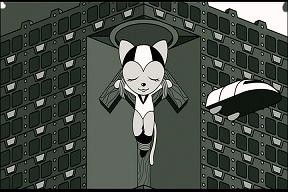
Having said all this, I suggest that the signature film for the Festival this year has to be Tamala 2010: A Punk Cat in Space (2002, Tol collective). Yes it’s from Japan and it’s animated, but this is no run of the mill anime, nor even a masterpiece of anime per se. It really and truly stands alone in a world saturated with work that can’t shake itself loose from the long arm of Akira’s (1988 Katsuhiro Otomo) influence. Indeed, the dominant anime style seems to be encapsulated by the work IG did for the Origin of O-Ren sequence in Tarantino’s Kill Bill. Of course I’m no anime expert, and perhaps me lumping in the O-Ren sequence with other anime work belies my ignorance of the myriad stylistic nuances found in the genre. All I know is that styles like those found in Akira and Kill Bill do very little for me. While I think the O-Ren sequence works well in setting up the overtly stylized live-action blood-letting at the film’s climax, and helps put Tarantino’s influence in context, I have simply grown weary of the constant anime emphasis on styles like this.
Enter Tamala. Stylistically, in its melange of unabashedly cartoony characters combined with state of the art 3D modeling, it’s closer to Metropolis (which screened at Fantasia 2001) than any other film I can think of. However, Metropolis approaches its blend of animation traditions much differently from Tamala. In the former film, the Tin-Tin like characters move about in a 3D modeled environment. The effect is stunning, and I believe Metropolis to be one of the finest animated works to date. Tamala, however, steps it up a notch by acknowledging the distinction between the two approaches to anime and having the story itself revolve around the implications of this distinction. The Hello-Kitty inspired characters exist in a world that matches their style, while a mysterious photorealistic 3D modeled world lurks somewhere in their sub-consciousness. The film effectively sets up a dream world that seeks to invade that of the waking, a cross-over between styles that suggests the end of the world as we know it. But of course, we can see this same principle at work in many animated films, not the least of which being another of my favourites: South Park: Bigger, Longer, Uncut (1999, Trey Parker), wherein hell is characterized by an animation style markedly different from that of the earth above, and the story revolves around the impending eruption of hell’s fire into the land of the living. Indeed, both Tamala and South Park are concerned with second comings, and both embrace the idea of contrast between the old and the new. The idea of context is very important here. Any exploration of how the old relates to the new necessitates an acknowledgement of context; new is only new in relation to the old. As I have suggested, Fantasia is a festival in which the acknowledgement of context is crucial to its fan base. Tamala is an epic treatise on the importance of contextualizing the new, and as such is the perfect film for Fantasia. And besides, it features an unspooling of conspiratorial hulaballoo that would satisfy any X-Files fan well beyond the average mythology episode. The secret societies at work in the feline galaxy run deep indeed.
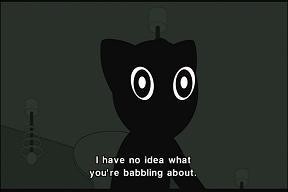
So what am I babbling about? Tamala is a tale of the importance of preserving memory and context in a universe saturated by late capitalism. A story of centuries old conspiracies unravelling between a network of planets inhabited by cats, the film revolves around a 1 year old feline who may just be the saviour of the universe, the one who will prevent traditional animation (represented by her and her worlds) from being usurped by a malicious secret society bent on change simply for the sake of selling product and gaining market share throughout the universe. Tamala struts around being a little brat, smoking, getting tattoos, and sexually soliciting a young stud named Michelangelo. Meanwhile, a robotic cat named Tatla, represented by her 3D modeling, has been infiltrating the minds of all children under the age of one in order to prepare them for her arrival in the feline galaxy and the destruction of the classic animation style in favour of the latest photorealism.
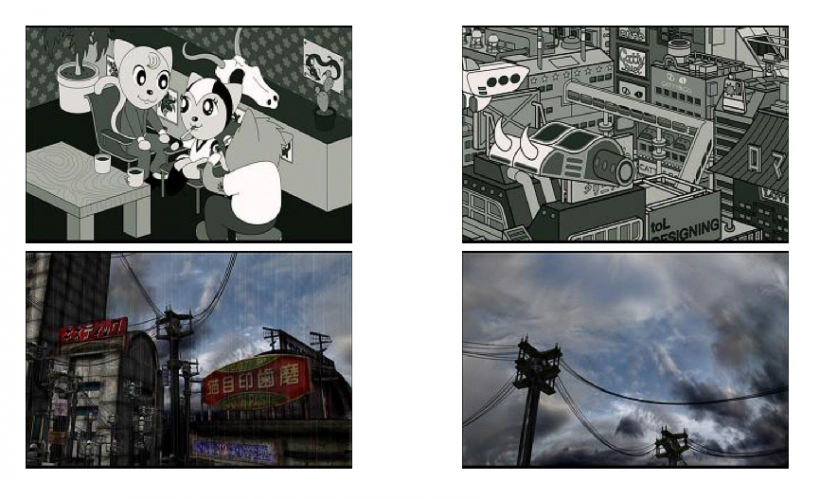
Upon first viewing the film seemed essentially non-narrative, but subsequent viewings revealed a very simple and surprisingly linear structure. In fact, the storyline itself is about tracing the linear history of Tamala, having apparently been alive for hundreds of years and is being used as an icon for the selling of Catty & Co. product even while she remains blissfully unaware of the whole scenario. While comparisons have been made to Thomas Pynchon’s The Crying of Lot 49 (1), there are also clear strains to the author’s Gravity’s Rainbow in which Tyrone Slothrop is being used by various agencies without his knowledge as he goes about his daily business of womanizing and chemical debauchery. In fact, Slothrop seems to have a unique capability to snuff out sites that are to be bombed in the near future. A map is created delineating the geography of his various sexual exploits around town, and becomes an infallible predictor of future targets by the enemy. Indeed, Tamala too is a little partyer, and sets her sights on a young cat named Michaelangelo very quickly. The couple seem to be wandering around aimlessly, but are closely watched by Catty & Co. agents, for her movements could lead to a major upheaval in the feline galaxy. A brilliant little moment comes when Tamala turns to Michelangelo and says: “Me very tasty. Won’t you eat me?” The sexual connotations are clear, but these words resonate more deeply when considering that Tamala is an agent of consumption, her likeness being consumed in vast quantities throughout the galaxy. This unwitting knowledge of her own plight through its manifestation as sexual desire is entirely Pynchonian, as Tyrone Slothrop’s sexual exploits in Gravity’s Rainbow have far greater significance than he realizes. It is also interesting to note that one of the products Tamala advertises is a memory enhancement drug, emphasizing her own quest to uncover the secrets of her past. Yet another connection to Gravity’s Rainbow might be implied, for the novel revolves around the mysterious oneirine, a substance that seems to affect memory.
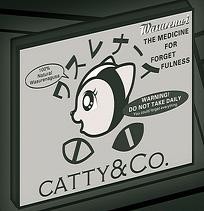
It is clear that, random as her movements may seem, she is being guided through the disclosure of her true identity and purpose in the galaxy, all of which seem connected to the constellation Orion. At one point, while perusing an art gallery, she descends to the basement to find a toilet and stumbles across an ancient chamber with a statue of Tatla and a giant wall painting depicting various ancient rites of cat-sacrifice. The idea that death is necessary for rebirth is at the heart of this story, and as we later learn, Tamala herself is a figure of sacrifice who must be consumed in order for her to find her place as saviour of the galaxy. Part of her sacrifice to consumption lies in the fact that her face can be seen on products everywhere, products which would be meaningless out of the context of consumerism. She is being consumed everyday, and this allows her to keep going.
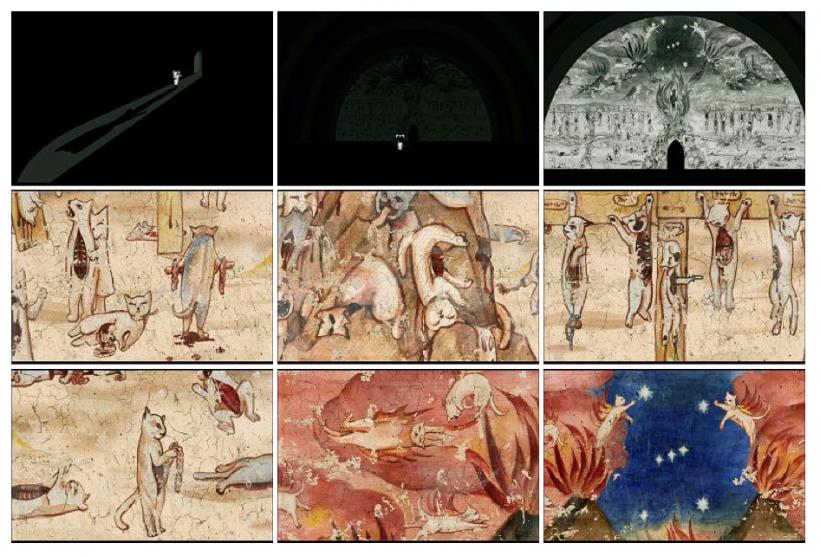
At another point, she and Michelangelo drop in on a concert, and the mosh-pit atmosphere all of a sudden gives way to that of a Nazi rally with Tamala taking to the stage and being saluted by the crowd as their leader. This is not quite a dream sequence, but more of a vision, a flashback, or perhaps even a flash forward to a time when Tamala will become recognized as the saviour of cats everywhere. The scene is disturbing in its fascist overtones, especially when these are later put alongside a Christ analogy, offering the idea that worship of Tamala as saviour is akin to the worship of a Nazi dictator. Indeed, as the wall painting she discovers suggests, violence seems a part of religion, with bloody sacrifice and world domination being a function of the organization of belief systems built into structures for the governance of people. And, as will be seen, Catty & Co. is most certainly bent on domination through consumer sacrifice, and has its roots in an ancient and highly organized society of cats centered around the mysterious religion of Minerva.
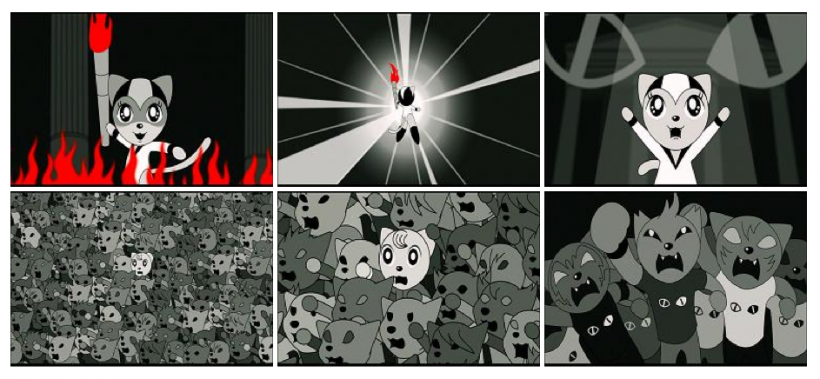
Indeed, there is a violent undercurrent throughout the film, expressed most overtly through street clashes between dogs and cats on Planet Q. This violence becomes one of the most important themes of the film when Tamala herself, midway through the film, gets ripped apart by a dog, reminiscent of Hitchcock killing of his leading lady halfway through Psycho (1960 Alfred Hitchcock) , and echoed by Tarantino slaughtering Travolta halfway through Pulp Fiction. Again, there are also strains of Gravity’s Rainbow here, in which the hero Slothrop disintegrates around two thirds of the way through the book, leaving only the traces of those on his trail to take up the rest of the tale. However, like Tarantino’s hero, Tamala resurfaces at the end of the film after a stunning regeneration sequence which brings the worlds of Tatla and Tamala as close as they have yet been seen on screen, further suggesting that she may well be the one that can cross the gulf between these two worlds and put an end to Tatla’s plans at infiltrating the blissful paradise of traditional animation with the obscenities of the photorealistic.
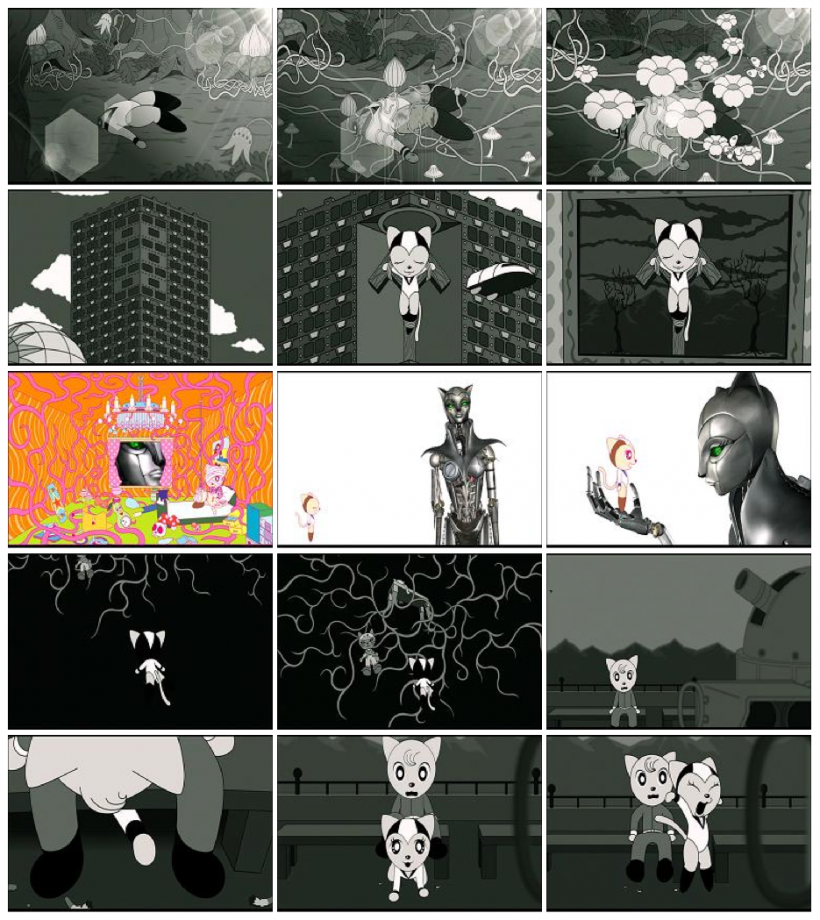
During her absence from the middle of the film, a mysterious professor enters the picture and holds a conference where he lays down an epic diatribe on the history of the Minerva cult, its relationship to Catty & Co., and how Tamala might fit into the picture. The scene is only slightly more coherent than Neo’s encounter with the architect in Matrix Revolutions (the only worthwhile scene in the film, if you ask me). The professor is then mysteriously killed, most likely by agents of the Minerva cult. But he too comes back to life, finds Michelangelo, and continues his lecture while his missing limbs fester with maggots. “I too am a cat who cannot die,” he says, and thus his quest to get to the bottom of Tamala’s place in the galaxy is related to a desire to come to terms with his own regenerative capabilities. Ultimately, these quests to understand regeneration are quests for contextualizing the present through attention to the past. Tamala, for all its efforts to draw on the stereotypes of postmodernist sensibility, is quintessentially critical of mindless deconstruction for its own sake, and places great emphasis on the importance of knowing one’s place in the world in order to act positively within it. By focusing on the importance of the concept of regeneration, the film ultimately suggests that to regenerate there must have been something that was generated before. This is the essence of intertextuality, and as we see in the likes of Kill Bill, there is great potential for creating works which explore their own interaction with the past. Because Kill Bill is primarily an aesthetic exploration of its own influences does not, in my opinion, diminish its value. For if aesthetics aren’t important, then why are we watching films anyway?
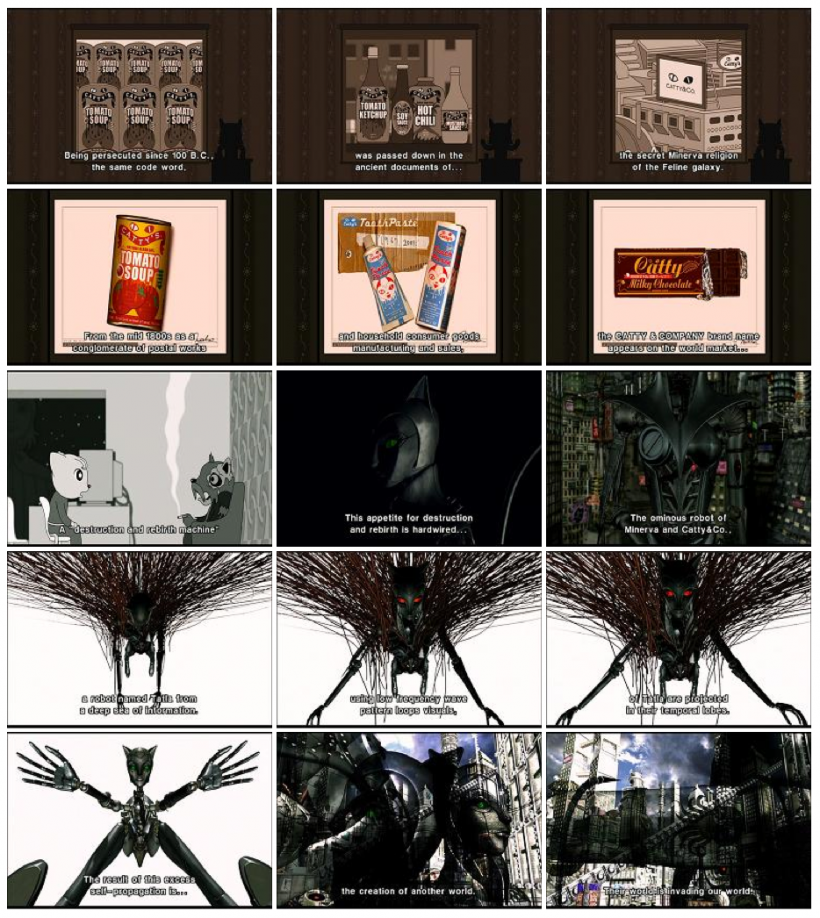
Aesthetics are certainly crucial for Tamala as well, and as I have suggested, there is a way in which the film can be understood as an acknowledgement of the current tension between the old and the new in animation styles. Tamala has the added benefit of working an exploration of the tension between old and new into its narrative through a focus on how regeneration is a function of the present actively engaging with the past. It is during the professor’s speeches that the importance of the past in understanding Tamala’s existence in the present is made known. Apparently, Tamala was stolen from her litter as an infant along with 200,000 other kittens, in order to be tested for her potential compatibility as a living embodiment of the robotic Tatla. She was the only one who tested positive, and so was employed by Catty & Co. to appear on the packaging of their products over the centuries in order to help them spread their power across the galaxy and establish the necessary networks for the final infiltration of the feline galaxy by the Tatla program. The professor explains that Tatla feeds off of destruction and rebirth, that consumer society is the perfect breeding ground for Tatla because of its dependence upon consuming and discarding product. Regeneration becomes the most important aspect of controlling the universe, and Tamala becomes the icon of death and rebirth, expressed most tastefully in the brief shots of her strapped to a cross in both modern and ancient contexts. She is the sacrifice that never quits, the little virgin that can be killed over and over in order to further the interests of the Minerva cult at the center of the Catty corporation.
The professor, however, wants to break the cycle, and free Tamala from the endless cycle of death and rebirth. And Tamala herself, while not necessarily conscious of her plight, seems to understand her need to break free. She expresses this need by a constant desire to uncover her own roots, and by the end of the film sets off for Orion to find the mother from whom she was separated as an infant, though closely watched by agents of Catty & Co. And so ends the first of three chapters in the Tamala saga.
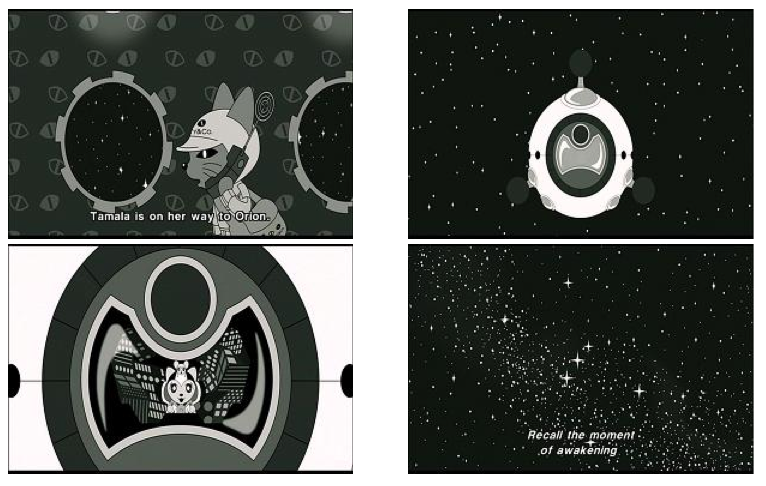
In many ways Tamala seems to suffer from the melting pot syndrome that so much work in the postmodern era exhibits, being a hodge-podge of cultural references squished together until the constituent elements become inserparable. But the film also argues for an awareness of context throughout history, and the idea that the old is constantly reborn into the new such that we can understand where we are now by looking at where we have been, and vice-versa. The narrative, being concerned with Tamala’s tracing of her own roots through the history of the economic development of the feline galaxy, is matched by the film’s aesthetic which posits two distinctly different stylistic approaches and explores their separateness and potential compatibility. The narrative expresses some distress over the possibility that the Tatla universe might merge with the feline galaxy, but the final upshot of such a union is not aesthetically revealed in this first instalment.
The film also exhibits that most postmodern of ironies that allows for adverstising to criticize and satirize itself in order to sell product. While the film seems to suggest that brand consciousness is what makes the propagation of heartless multinational corporations thrive, the merchandising surrounding the film buys right into the premise that its narrative seems bent on destroying. Indeed, I bought into it right away. After the film screened, I rushed out to the Tamala table set up in the lobby filled with key chains, figurines, CDs, CD-Roms, DVDs, mousepads, posters, t-shirts, etc. The DVD, of course, was a no-brainer. The CD seemed like a no-brainer too, but soon after dropping $45 I was very disappointed to find that none of the film’s techno score was included, leaving only the TOL grunge-pop which, while not bad, is not something I would listen to very often. The CD did come with a little black cat figurine marked with the Catty & Co. logo, so it wasn’t a total waste. And I’m enjoying my keychain and poster immensely. The most disappointing was probably the CD-Rom which contains little more than a series of clips from the film in the form of Realplayer files, totally redundant when one has the DVD in hand. But the packaging on the CD-Rom was very nice, filled with images of the various Catty & Co. products that were graced by Tamala’s visage. And so I left that night more under the consumerist spell than ever before, thus rendering Tamala’s well-rendered exploration of consumerism ultimately ineffectual in the real world of my own life. Oh well. I prefer to think of my purchases as a desire to keep Tamala alive outside the context of the film, to engage in an intertextual environment whereby I can look at these little mementos in my room and be reminded of the film, calling attention to my engagement with film outside of the actual experience of watching it. Thus, I have a constant desire for the regeneration of past experience through ownership of product. Intertextuality, in this sense, becomes a playground for the co-option of entire lives under the guise of brief moments of escapist entertainment. But mostly, I just really loved the film and wished it would go on forever. Indeed, just as Tamala awoke from her sleep at the beginning of the film with a tear in her eye, so too did I shed a tear (figurative though it may have been) upon awaking from the dream of this wonderful film, and indeed, many more tears at the end of the festival itself.

The festival’s final word on consumption and sacrifice, though, was most certainly Suicide Club, also featuring a secret society bent on controlling young lives through rampant consumerism. The agenda here, however, is sacrifice for its own sake, wherein groups of teens gather to engage in mass suicides under the influence of the idea that it would be fashionable to do so. Indeed, the film starts with a bang: 30 teenage girls standing at a subway stop, holding hands and singing joyfully as they await the train’s arrival. As it pulls in, they all throw themselves in its path, and an epic wave of blood and guts splatters the entire platform as the girls get munched on the tracks – a startling depiction of the excess and waste of consumer society bent on making people feel a part of something when really their lives are being destroyed. The girls’ actions are the ultimate manifestation of what most corporations would want: for consumers to give their lives over to the flavour of the moment. The film was easily one of the best in the festival this year, and was the hallmark for a the theme of suicide which came up time and again throughout the programming.
My Sassy Girl (2001, Kwak Jae-young) begins by toying with the subway suicide trope when the main character is first seen teetering on the edge of the station. As it turns out, however, she is merely hammered out of her mind and was oblivious to the danger she was in. Nothing to Lose (2002, Danny Pang) followed a young couple who meet on a rooftop while about to kill themselves. They then decide that, since they had planned to die anyway, they might as well go on a citywide rampage until finally, when conrnered by the police, they finally follow through on their original plan and hurtle themselves into space, Thelma and Louise style. The Invisible (2002, Jeol Bergvall, Simon Sandquist) features an elaborate D.O.A-type scenario where a teenage boy lies comatose from a gang beating, but his ghostly spirit wanders about in a race against time to convince someone that he is still alive. When his body is finally found he is so far gone, that he convinces the girl responsible for his beating to perform a mercy killing. Public Enemy (2002, Kang Woo-suk) begins with police partners sitting in a car when they get the word that internal affairs is mounting an investigation on them. One of them promptly whips out his gun and blows his brains out. In Old Men in New Cars (2002, Lasse Spang Olsen), a woman throws herself off a building and crashes hard through the roof of a car parked on the street below. However, she gets up from this without a scratch other than a newly acquired state of amnesia. In Shark Skin Man and Peach Hip Girl 1998, Katsuhito Ishii), a character removes a single bullet from a fully loaded revolver and plays a little game of Russian roulette. When he manages to squeeze the trigger on the empty chamber, he exclaims: “Lucky me.” In My Skin (2002, Marina De Van) was one of the more in-depth explorations of self-destructive behaviour, being the story of a woman obsessed with the scarification of her own flesh. Easily another of the festival’s best films this year, it also provided an interesting counterpoint to two other tales of self-destruction offered by festival favourite Takashi Miike, whose interest in the themes of suicide and regeneration will be considered in some detail in the second part of this Fantasia report.
Read Part 2 Here.




